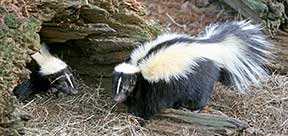 |
Previous Issues |
| Cedar Mill Community Website |
|
Search the Cedar Mill News: |
About The Cedar Mill News |
|
|||||||
| Volume 14, Issue 4 | April 2016 |
||||||
An unwelcome odor of Spring!
|
|||
 |
Yes we do have skunks, and it seems like we have more of them this year than for many previous years. Most animal populations vary over the years—based on disease prevalence, numbers of predators and other factors. I asked the main vet at the Audubon wildlife center and she didn’t know why we have more skunks this year compared to the last few years.
As a result of being awakened many times in the past weeks, around 2 am with a very strong smell permeating the neighborhood, I was sparked to research more about these nocturnal animals. Hopefully what I found in my research will be of interest to my Cedar Mill neighbors!
Two types of skunks live in Oregon—striped and spotted. The ones I have seen dead on the roads were striped, but what their coats are like really doesn’t matter much to their behavior.
Skunks are considered generally “beneficial” to humans—certainly that statement can incite some reflection about whether that is a suitable frame by which we judge animals. They definitely have a place in a healthy ecosystem. They eat grubs and insects. They will also eat pet food if left out, garbage that is not covered, and items from your garden! What eats skunks? Coyotes generally avoid skunks but Great Horned Owls and Red Tailed Hawks are great skunk eaters.
Hopefully we can live together peacefully, but when the populations get so large that the spraying and destruction cannot be tolerated, there are trappers, licensed and regulated by the ODFW, who can trap and release these creatures into more remote parts of Oregon. While of course there are no guarantees that such released animals will thrive, I am heartened by the thought that goes into where these animals are released so that only one pair are released in one habitat. A study by an Indiana wildlife expert documented that urban skunks have a short lifespan, with many riddled with parasites and other diseases. Clearly the above-mentioned raptors also eat them as well.
I have enjoyed learning more about these creatures we rarely get to see. Hopefully you do NOT smell them but rather are enjoying the more delightful spring smells in Cedar Mill of the Daphne and Hyacinths.
Lauretta Young MD has a private practice in Cedar Mill and also takes learners out on custom birding tours in Cedar Mill and beyond (www.portlandbirdwatching.com).
![]()
Like us on Facebook for timely updates
Published monthly by Pioneer Marketing & Design
Publisher/Editor:Virginia Bruce
info@cedarmillnews.com
PO Box 91061
Portland, Oregon 97291
© 2016